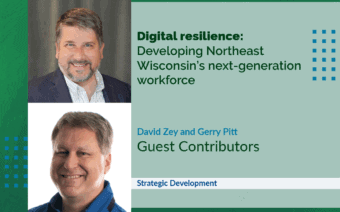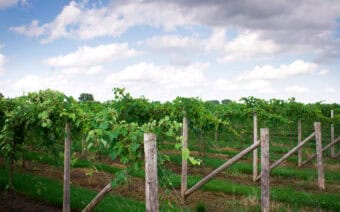
October 21, 2024
DOOR COUNTY – Michelle Lawrie, executive director, Door County Economic Development Corporation, said the former chairman of the Federal Communications Commission’s statement about broadband has never been truer: “Broadband access is the great equalizer, leveling the playing field so that every willing and able person… has access to the information and tools necessary to achieve the American Dream.”
While discussions of how to expand broadband throughout the state are several years in the making, so are plans to begin allocating grants for broadband expansion through the Broadband Equity, Access and Deployment (BEAD) program.
The program includes $42 billion for high-speed Internet access funded by the Bipartisan Infrastructure Law.
Its goal is to get Americans online by funding partnerships to build needed infrastructure and increase the adoption of high-speed internet.
It will provide grants for service providers expanding broadband service in unserved and underserved locations.
She said Door County’s 19 communities have faced unique challenges in securing broadband, but in the process, have numerous insights and takeaways to share.
Key broadband terms top of mind with anyone working to secure broadband, including in the New North, Lawrie said, are “unserved” and “underserved.”
BEAD funding prioritizes unserved locations (that have no internet access or that have access under 25/3 Mbps) and underserved locations (which only have access under 100/20 Mbps.).
According to the New North, there are 546,698 broadband service locations within its 18-county project area.
Of those, 76% are considered served.
Another 13.3% are defined as underserved, and 10.4% are unserved.
Of the 206,577 locations eligible for BEAD funding in the state, 55,882 of those are within the New North’s 18-county region.
Having so many underserved and unserved areas, Barbara Koldos – vice president of business development, New North, Inc. – said, poses challenges to the residents and businesses in those areas.

Whether it’s used for supporting education, fostering better public health, conducting business transactions or providing a means to strengthen social ties, Koldos said broadband access provides multilayered impacts.
“It’s the idea of the internet for all,” she said. “We want every business, person and location (in the region) connected to broadband because it makes economic sense. Whether it’s a large business that needs access to do business globally or a small business that needs it to process payments, it makes good business sense to have good internet access.”
Just as with electricity and running water, Koldos said high-speed internet is an aspect of infrastructure – people expect electricity when flipping a light switch and drinking water when they turn on the tap.
Likewise, people expect access to reliable internet in today’s world, she said.
“Everyday life revolves around the internet, yet people in our region do not yet have access, or adequate access, to it,” she said.
The repercussions of not having broadband access, Koldos said, are multifaceted.
“It’s about quality of life, and it’s also a key aspect for business attraction and economic development,” she said. “People expect (broadband internet). Economic development is no longer about companies moving somewhere and expecting people to follow. People migrate and companies find a place where the people are. And a key part of people moving to a location is high-speed internet. When people are considering a move, they’re going to ask, ‘What’s the school district like?’ ‘What are taxes like?’ and ‘Is there high-speed internet?’”
Collaboration, Koldos said, is key in creating momentum in defining how to secure funding and successfully pursue broadband in underserved and unserved areas.
She said that’s why joint efforts, such as the New North Broadband Alliance, exist.
Created in May 2023, Koldos said the alliance is helping 16 New North counties prepare and optimize their grant requests for BEAD through collaborative efforts.
A collaborative effort of regional and statewide organizations, including the New North, Wisconsin Broadband Office of the Public Service Commission, National Telecommunications and Information Administration and Wisconsin Towns Association, aims to help support each other’s broadband efforts.
Broadband: A healthcare perspective
One of those panelists is Brian Stephens, CEO/president of Door County Medical Center. Stephens said he knows broadband is essential to the healthcare industry in a multi-pronged way – starting with patients.
In today’s world, he said most people access their healthcare records, labs, etc. in portals via a website or app.
“And obviously, that works best if you have high-speed internet,” he said.
Stephens said Door County Medical Center experienced an increase in virtual visits during the COVID-19 pandemic out of necessity.
But the desire for virtual visits, he said, continued long after for follow-up visits not requiring a physical examination.
However, patients’ ability to tap into this convenience, Stephens said, is contingent on where they live and their broadband access.
In addition, patients who work through the center’s partner healthcare organizations for specialty services, such as cardiology, Stephens said seek reliable broadband for cardiology monitoring, for example.
“There is a lot of personal monitoring of cardiac health and activity on people’s smartphones, and those technologies only work if someone has regular access to high-speed internet, preferably within their home,” he said. “Otherwise, (the technology) can’t record things or provide feedback in a timely manner.”

Further, Stephens said health care is like any other industry that seeks broadband as a common denominator for talent recruitment.
“Extensive broadband is critical,” he said. “A doctor or nurse on call needs to (reliably) receive secure text messages. Right now, these folks are limited as to where they can live in the county as they have to have access to high-speed internet. With the existing housing crunch, that further limits where they can live, which (compounds the issue).”
Door County’s unique challenges, assets
Jessica Hatch, broadband coordinator, Door County, said underserved and unserved are key terms the 19 municipalities on Wisconsin’s peninsula are well-versed in.
“Broadband access in Door County has always been a struggle, being such a rural area,” she said. “It’s been part of ongoing conversations under economic development for many years. In some of our municipalities, it’s been a topic of ongoing discussion for 15 years.”
Hatch said the county has some unique challenges – one being its rural nature.
Though northern Door County features many small businesses, Hatch said southern Door County is heavily agricultural.
Though many people’s default is to think of the county as a tourism destination (which it is), Lawrie said she is quick to point out that attracting talent requires mindfulness of factors that figure into the quality of life.
And among them, she said are access to broadband, housing and childcare, which are a few of the most challenging statewide.
“We want to make the (broadband) experience better for everyone – it is all-around important to us,” Lawrie said. “But we are really focused on attracting the young families we need to live and work here year-round. If we don’t have the broadband capabilities families need for education, entertainment or daily life, we’re not going to attract them. And we need them for our year-round economy.”
Another county-specific challenge, Lawrie said, is that the rock resulting from the Niagara Escarpment makes fiber installation challenging, as is the county’s consistently ranking No. 1 or 2 in the state for having the oldest demographic.
As the population continues to age, so, too, Lawrie said, does the number of people vacating the workforce.
“We have an aging population here and need to attract younger families to Door County,” she said. “Broadband is a huge part of that.”
Despite challenges, however, Koldos said the county has been a frontrunner in tackling needed broadband infrastructure.
“Local officials within the Door peninsula have proactively addressed the county’s broadband needs – of residents, businesses and visitors – successfully in recent years,” she said. “We will hear their updates, along with exploring insightful case studies from throughout the region that offer valuable lessons for everyone.”
Hatch said another unique aspect of the puzzle is her role as the county’s dedicated broadband coordinator – a role she has held since April 2022 – which was the first of only two roles like it in the state (the other being in Dane County.)
“An important takeaway from a study and asset mapping was, ‘You’re not going to get anywhere with this movement unless you have a designated full-time person to spearhead this work,’” Hatch said. “(Fortunately), the county and others saw broadband as one of the top three areas of work – childcare, housing and broadband.”
Answering the question: Why broadband?
Hatch said municipalities are addressing broadband funding gaps differently, with some struggling to gain traction with tax levies.
That’s why sharing the economic impact, she said, is an important part of the story to create an understanding of “why broadband” for all segments of the population.
“In many of these scenarios, it’s about helping people have a better idea of how the money is going to come back to them,” she said. “It’s going to, it’s just in different ways.”

On a municipal level, Hatch said she has discovered the county is unique in how involved the municipalities are in making broadband decisions.
Because broadband is considered infrastructure (albeit not as a utility-managed infrastructure, such as water or electricity), Hatch said municipalities have the authority to proceed with borrowing to invest in infrastructure.
Some of the county’s municipalities, she said, have said “yes” to this, whereas others have taken the topic to referendum but failed.
“We have an opportunity to help them rethink proceeding with a tax levy – as they have the power to do that – as the (benefit) will come back to them,” she said. “Broadband is crucial infrastructure. Even though it isn’t deemed a utility at this point – it really should be.”
Though the 19 communities in Door County have varying degrees of internet access, Lawrie said it’s important for the community to understand the impact close to home.
“We are proud of the successes of our local efforts to improve broadband access and quality,” Hatch said. “But we know that broadband lines don’t stop at the county line, so working as part of a regional effort is essential. We will benefit from hearing the perspectives of our regional and state broadband partners.”
Hatch said the county needs to appeal to young families and bolster its workforce.
“Tourism doesn’t work without people to work here,” she said. “Wisconsin is one of about 16 states with restrictive legislation that doesn’t allow for municipal broadband in the state unless you’re already a utility provider, yet what it brings to the area is massive.”
Secondary residents for economic development
A topic of discussion in relation to broadband, secondary residents, Lawrie said, have been top of mind with the county – these being people who own homes in Door County but do not list Door County as their primary residence.
A study commissioned by the Door County Economic Development Corporation and the County of Door Broadband Office, she said, revealed the importance of secondary resident activity in the county.
“We are concerned about primary residents to be sure, but it’s important for secondary residents to stay in the county longer, too,” she said.
The numbers, Koldos said, indicate why.

The New North’s 18 counties include six of the 20 counties in the state with the highest percentage of secondary residents.
These secondary residents revealed that internet access is a major barrier that prevents them from enjoying Door County for longer periods.
In addition, the study states that 64.8% of secondary residents said broadband availability would influence whether or not they eventually move permanently to Door County.
The study also found that secondary residents would stay in Door County for about 15 more days per year if they had access to high-speed internet.
Those longer stays, the study reports, equate to an additional $750,000 in state and local taxes (not property taxes) and would generate more than $18.6 million in additional economic impact:
- $13 million through direct spending
- $3.4 million through indirect effect (the added spending businesses would do to provide goods and services)
- $2.2 million through induced effect (changes in household spending because of additional employment from direct and indirect effects)
Takeaways to benefit all
Hatch said seeing folks have light-bulb moments about why broadband is important to economic development in general, as well as closer to home in their industry, place of business or home inspires her.
“For me, it’s (exciting to see) passion ignited in someone else on why broadband is important,” she said. “Whatever we’re spending, it will come back to us in some way by having that fiber available to us.”
Hatch said its premise mirrors that of a lot of the work on broadband in that it’s collaborative, which is a necessity for a need of this sweeping nature.
“When you think about it, the last time we did something like this was the Rural Electrification Act of 1936, and I don’t think anyone is going to give back their electricity,” she said.
Hatch said that law allowed the federal government to give low-cost loans to farmers who banded together to create nonprofit cooperatives to bring electricity to rural America.
“It’s a matter of correlating to people that this is the next electricity,” she said.
In addition, Hatch said sharing best practices, case studies, hard-won wisdom and more are essential to helping communities secure funding and support for broadband.
“One size doesn’t fit all in this work – you have to pull everything at a local level and look at what the lived experience is,” she said. “Someone in the City of Sturgeon Bay, which is considered served with broadband, versus someone on Gills Rock can’t be compared. It’s important to look at this at a micro level and find engaged people willing to do the work.”
For more information, visit fibernetdoorcounty.org.
 Oshkosh Corp. renames Defense segment, appoints Nordlund as president
Oshkosh Corp. renames Defense segment, appoints Nordlund as president ‘It’s never too late to follow your dreams’
‘It’s never too late to follow your dreams’







